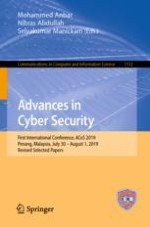2020 | Book
Advances in Cyber Security
First International Conference, ACeS 2019, Penang, Malaysia, July 30 – August 1, 2019, Revised Selected Papers
Editors: Dr. Mohammed Anbar, Prof. Nibras Abdullah, Dr. Selvakumar Manickam
Publisher: Springer Singapore
Book Series : Communications in Computer and Information Science
